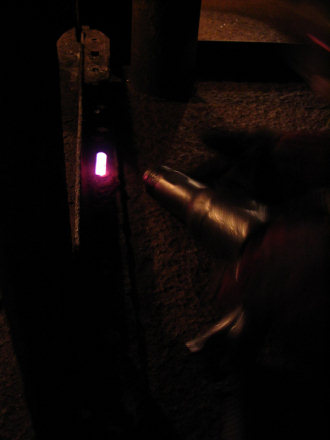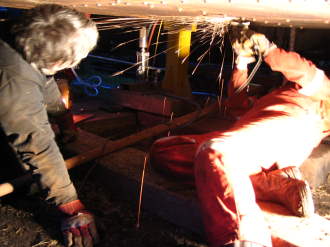RIVETTING
|
|
|
Robin getting into
position for a spell of rivetting. The rivets are put in from underneath
and the heads formed from above.
|
The hot rivet is shown here held in place by the hold-up tool, ready to be rivetted over. |
|
Ian and John ran a 9/16" drill through the holes to ensure the rivets will fit, and are here seen cleaning up the holes with an angle grinder prior to putting the rivets in. Two people are needed under the tender, one to operate the hold-up tool, and one to offer up the rivets. An extra person is useful to relay messages to the person inside the tank, but as we developed an understanding, we found we could still work with only 3 people if required.
|
Forming of the head in progress. Due to the cramped conditions and the closeness of the rivets to the back of the steel angle, some of the heads were quite difficult to form, but we got there in the end. |
|
Ian and Iain pose beside our gas forge. It has two burners. One is currently not fitted as one burner is sufficient required to heat the rivets, but the forge still uses quite a lot of propane.
|
Forming the head is almost complete. As the rivet cools, it contracts, pulling the rivet tight to the base of the tender. Once all the holes are filled, the bolts are removed and the remainder of the rivets put in. |
|
The pneumatic hold-up
tool with it's flat base attachment. The tool is positioned beneath the
hole and the hot rivet offered up with tongs. When air at 100psi is put
onto the tool, the ram extends, holding the rivet firmly in place, ready
to be rivetted from above.
|
Some of the rivets need to be countersunk so they don't foul the frames. It's difficult to rivet from below with a flat hammer, so we made up a former and made our own countersunk rivets from some of the dome headed rivets. |
|
The hot rivet is shown
here being taken from the gas forge. It has previously been cut to
length in the chop saw. The heavy usage the forge has had over the last
couple of weeks has caused a certain amount of damage to the refractive
lining, which will need repairing. However, the forge, designed by Ian
from ideas taken from several American websites, has been a complete
success.
|
Some of the completed rivets. |
| Back |
© The Carmyllie Pilot Company Ltd 2004 |









